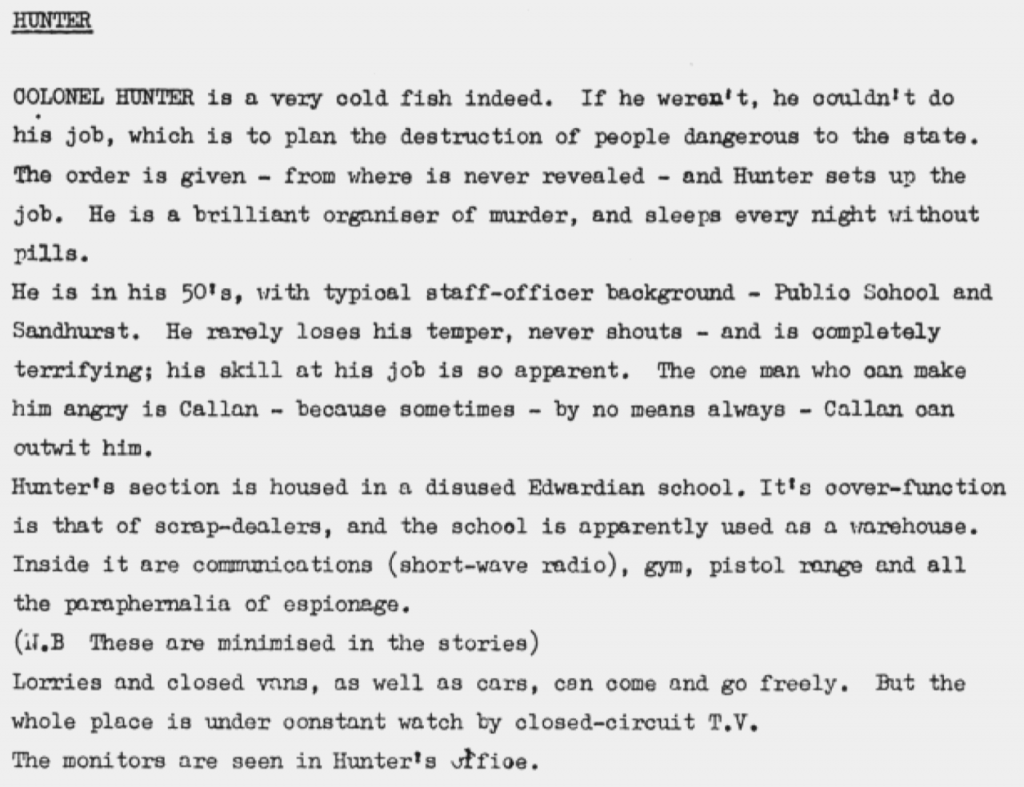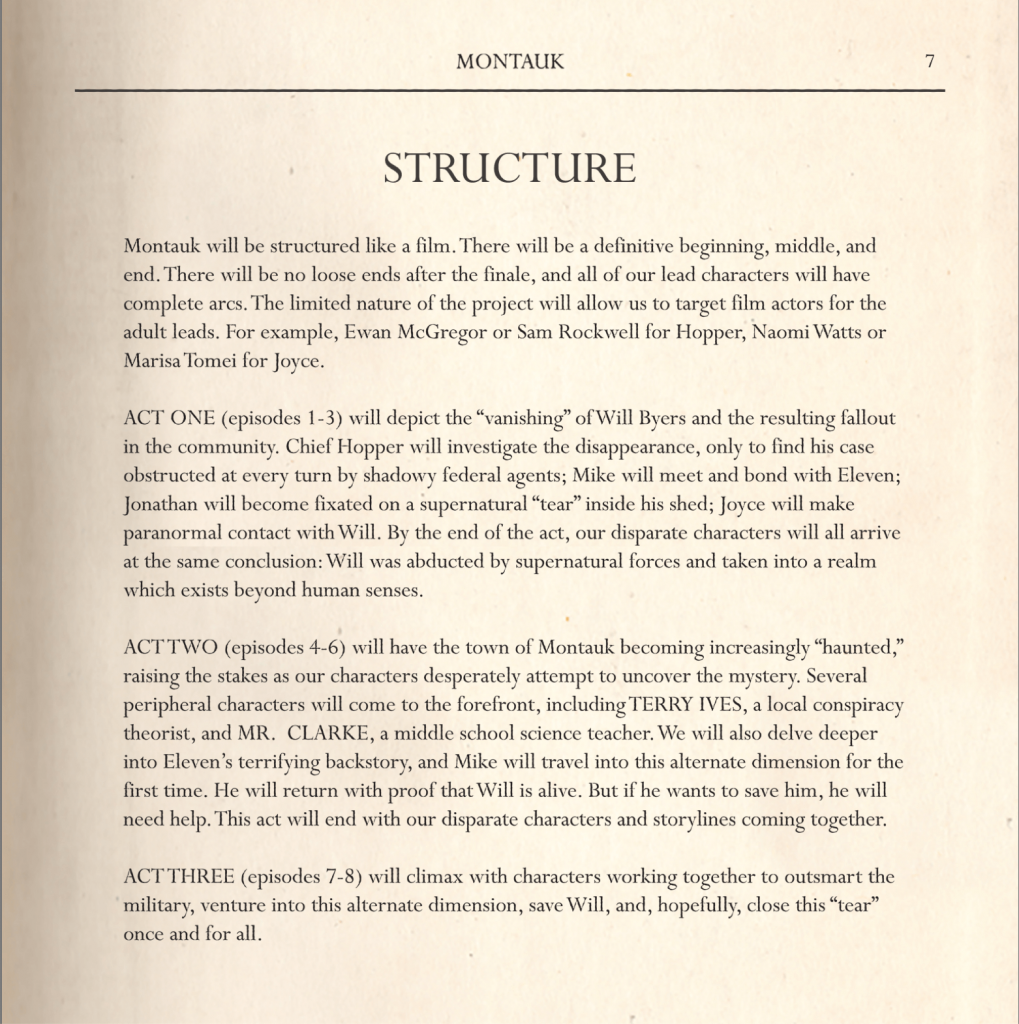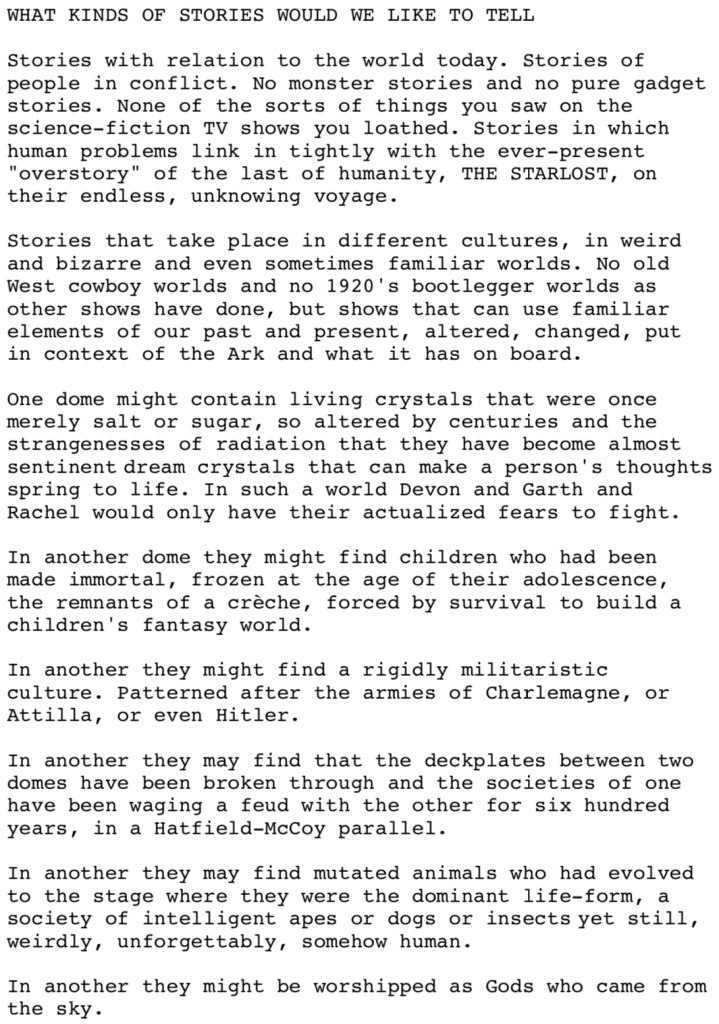
Learn how to write a TV show bible and market your pilot like a pro.
So you’ve got a great idea for a TV show…
Do you just write the pilot and start sending it out into the industry? Or do you first write one of those mysterious things known as a “TV show bible”?
If you want to learn how to write a series bible but are unsure what it should include, where to start or whether you need to write one in the first place, look no further.
In this post, we’ll be covering:
• Do you have to write a TV show bible? And if so, when?
• TV series bible template and format
• 40 TV show bible examples to download and study
And much more. So let’s dive on in!
What is a TV series bible?
A TV show bible is a 5- to 15-page document put together by a writer to help them sell their TV show.
A well-put-together TV series bible is an in-depth blueprint of the show—story world, tone, plots and characters, etc.—and how each develop during season 1 and beyond.
Think of it as a selling tool that will help a TV studio or network understand the show on a much greater level than is possible from just reading the pilot.
The way it generally works is that if you get a request to read your pilot, and they like it, then they’ll request your TV show bible.
Overall, in Hollywood-speak, the purpose of a TV series bible is to convince an exec or producer that your pilot is not just a one-off great piece of writing but that it has “legs.”
In other words, a huge potential for many seasons full of great characters, exciting plot twists and, let’s face it, a monetary payoff for the studio or network involved.
Pitching feature scripts vs. pitching TV scripts.
This is the key difference between pitching and selling a spec feature script and a TV pilot. A feature script can stand on its own as a selling tool because it’s a story that’s done and dusted in two hours.
As a TV writer, however, you’re not just pitching a self-contained two hours of story— you’re pitching hours and hours of story that’s yet to be written.
The purpose of a TV series bible is to get people excited about all the problems that may arise for your characters after the pilot.
When a show gets picked up, its bible morphs into a living thing…
When a show hits production, the TV series bible gets regularly updated with detailed information on all the stories and characters as it progresses.
Famously on Frasier, every little detail was recorded in its series bible, from Martin’s favorite bar to Niles’ favorite professor, to Maris’ multiple food allergies.
This document then serves as a living resource for all the writers to make sure everything remains consistent within the universe of the show.
It gets updated by the script coordinators and writers’ assistants who, by the way, are expected to be able to reel off information from it at the drop of a hat.
Note: the name “TV show bible” or “series bible” is not set in stone.
The term “TV show bible” is not a fixed industry term. You may hear it referred to it as anything from “extended pitch,” to a “proposal,” to a “pitch bible,” or even, confusingly, a “TV treatment.”
It’s also sometimes referred to simply as “the book.”
Overall, the term “TV show bible” or “series bible” can mean different things to different people depending on who you’re talking to.
Therefore, if you’re asked by an executive or producer to send one in, the best thing to do is ask them specifically what kind of document they’re looking to read.
Sounds like a lot of work… Do I have to write a TV series bible?
No, but if you want to break into writing for television you’re seriously hampering your chances of doing so if you don’t have a TV series bible. Along with your expertly-crafted pilot script, it’s the most important document in your portfolio.
Don’t make the mistake many aspiring TV writers make of writing a couple of TV pilot scripts and then start knocking on doors. The studios and networks aren’t necessarily going to be interested in reading just a single pilot script.
They’ll want to be able to envisage entire seasons beyond just the opening episode. As good as that 30- or 60-page episode may be, it’s never going to be able to cram all the cool upcoming ideas you have for an entire season or more into its pages.
And don’t forget you’re only going to get about ten minutes to pitch during a general meeting, so it’s a good idea to leave behind more evidence of your show’s potential than just the pilot.
When should I write a TV series bible?
Whether you write the show bible before or after writing the pilot script is up to you. Some writers like to write the script first and then the bible. Others prefer to write the bible first in order to really explore the show on a deeper level than is possible in just a treatment or synopsis.
In either case, it’s a good idea to have a TV series bible in your portfolio before you start marketing your pilot as you will likely be asked to produce one if people like the script.
Writing a TV series bible means there’s no need to write multiple episodes.
A common mistake aspiring TV writers make is instead of writing a series bible, they write multiple episodes of their first season.
There’s nothing wrong with being able to produce six episodes out of your back pocket during a meeting, but if you don’t also have a TV series bible, it shows a little naivety of how the industry works.
Most execs and producers don’t have the time to read ten episodes of a show. All they want to read is a single document—a condensed version of the tone, stories, characters, arcs and themes of the show’s world.
TV show bible template.
Now let’s take a look at how to actually put together a TV series bible.
Below are all the different areas typically covered in a show bible. Some of these are covered in great detail in professional bibles, others less so, but the average document will at least touch on most of them—whether it’s a single sentence or several pages.
Show and writer name.
Of all the elements on this list, these are the only ones that are mandatory. It may sound incredible but many writers forget to add their show’s title and their name on the cover page.
This is not to say that you will always find them on TV show bibles written by professional writers, but here’s how the cover page looks on the bible to Lost:
 Quote or definition.
Quote or definition.
You may wish to add a quote or definition on the next page that explains or encapsulates your show’s mood and tone, but it’s not required. For example, this is the first page of the series bible to Fargo:

Table of contents.
Some writers include a table of contents of what’s coming up in the series bible, although it’s not necessary. Here’s how the writers of Lost did it in their bible:

Logline.
A one- or two-sentence summary of a TV show’s concept intended to sum up its core conflict and reason why people would want to watch it. Not just the pilot, remember, but multiple seasons.
For example, here’s the logline to Stranger Things:
“When a young boy disappears from a small town in the 1980s, his mother, a police chief, and his friends must confront terrifying supernatural forces in order to get him back.”
Again, most modern show bibles omit loglines these days and tend to simply build upon the idea behind it in the “one-sheet” below. However, there’s nothing to stop you from adding a logline upfront if you wish.
One-sheet.
This is how many professional series bibles kick off: with a captivating but brief lowdown of what the show’s all about, usually in around 200-300 words.
It’s a summary of the show—the writer’s broad master vision of what their show’s going to deliver in a general sense.
It gives the reader an idea of the kind of characters we’ll be following, the kind of conflicts they’re going to face and the story world and tone—all intended to hook the reader right off the bat.
There’s no “right” way to write a one-sheet but it could also reference the show’s structure, format, genre, mythology and other shows it’s similar to: “Imagine if Show X had a baby with Show Y…”
Here’s how the writers of Terra Nova get the essence of their show across in 209 words:

Personal statement.
Many writers also like to include somewhere at the beginning of their bible a short exploration of how they got the idea for the show and what they want to achieve with it. In other words, why they wrote it in the first place.
This personal statement is sometimes given its own heading and sometimes incorporated within the one-sheet in a more free-flowing manner, such as here in the New Girl series bible:

It goes on a little longer but you get the general idea. There’s a seamless transition here between stating what the show’s about generally and the writers’ inspiration for
writing it.
Character breakdowns.
Now it’s time for the TV show bible to dig a little deeper into the story world. Either by diving straight into the story (which we’ll come to in the next section) or by exploring the show’s main characters.
In this section, the writer lays out each of the major characters (and some of the minor ones if they’re important) in the story. This means describing their backstories, goals, conflicts with other characters, secrets, fears, flaws, arcs, etc.
The trick here is to keep each bio tightly written and super focused on giving the reader a well-rounded sense of who each character really is deep down.
Here’s a beautifully concise example from the series bible to Callan:

You will also see many writers also choose to devote a section to the dynamics between the characters, as shown below in The Crow series bible:
Story world.
It’s often at this point in a TV series bible that the show’s setting gets its own heading as it is, after all, almost as important as the story and characters.
This TV show bible to Family Biz, is a great example of how to vividly convey the locations we’re going to be inhabiting during the show along with the characters:

(Note: Not all writers give story world its own heading. Some prefer to simply emphasize the setting and locations throughout the bible.)
Tone, genre and style.
These elements can simply be referenced throughout the show bible (particularly in the one-sheet), or given their own sections, or rounded up into one.
In the Lost television bible they open the section by explaining all the different genres the show encompasses before ending with:

Season 1 overview.
After the characters and story world have all been introduced, an overview is often given of how the first season will play out. How will the conflicts, desires and problems the characters are forced to grapple sustain itself over multiple episodes?
Again, there’s no “right” way to write this and different writers like to give a sense of what to expect in season one in different ways.
For example, in the show bible to Dad’s in the Attic, the writers have a section called “Character Arcs for Season One” that briefly describes the structure of the show, before outlining what happens to each major character during the first season.
The writers of Dirk Gently’s Holistic Detective Agency also focus on their main characters in this section of their TV series bible.
On the other hand, for Stranger Things the writers craft a section called “Structure” which paints a vivid picture of season 1 as a structurally tight feature film:

Season 1 episode summaries.
Now, instead of learning about the main characters’ wants, needs, arc, etc. over an entire season, we get to see them broken down in each individual episode.
How a writer approaches this differs depending on whether the show is a serial, such as Revenge or Big Little Lies, or episodic, such as Curb Your Enthusiasm or Star Trek.
If it’s serialized, the episode summaries will need to give a clear idea of how the central story arcs over the course of each episode before its climax at the end of the season. This style includes hooks at the end of each episode and tracks where all the major turning points occur, similar to a movie outline.
An episodic TV show, meanwhile, doesn’t need to do this as each episode starts afresh. The emphasis here is more on outlining all the character conflicts and story dramas within a singular episode.
Characters can, however, still have arcs during a serialized show, and so these should be included if relevant.
Some writers choose to skip the previous season one overview altogether and just include this part. Others include both so it’s totally up to you.
Here’s how the writers of the serialized show True Detective break down episode 1, before laying out the following seven:
(Note: Many writers also choose to give each episode here a title, rather than just “one,” “two,” “three,” etc.)
Future seasons overview.
Next up, in order to really give the impression that the show has “legs,” most writers include an outline here of how future seasons might play out.
The idea is to convince the exec or producer that there’s longevity to their show. It has enough conflict in this story world and within its characters to sustain multiple seasons.
For example, here’s how the writers handled this in the TV series bible for The Starlost:

Other elements.
There are an indefinite number of elements and headings professional writers include in their TV show bibles—mainly because they make up the “rules” as they go along.
Whole sections are often devoted to obvious elements such as theme, structure, mythology and format.
The most important thing to remember is this: anything that’s different and original about a particular show needs to stand out.
This is why the show bible to True Crime contains sections labeled, “A Unique Structure,” and “Humanism,” and in Terra Nova we see the heading, “A Word About Dinosaurs.”
The bottom line is: what’s original about your show needs to be placed upfront and center in the reader’s mind—however you choose to format it.
A word on concept art.
The majority of TV show bibles that pass through our Synopsis/Treatment coverage service contain some kind of concept art.
Some look absolutely fantastic. Others, not so much…
While there’s nothing wrong with adding artwork or photos to your bible, it’s important to make sure they look professional and help sell the story rather than distract from it.
If you want to add concept art, consider hiring a professional designer to help put it all together and create a document that captures the tone and style of the show as well as the reader’s imagination.
One of our script consultants, Jenna Mattison, uses the talents of Gaetano DiCarlo (gaetanodicarlo [at] gmail.com) to design her show bibles and says execs love them.
TV series bible format.
Most writers break down their TV bibles into clearly identifiable sections, simply because it makes for an easier read. Others, however, prefer a more free-flowing style, as already demonstrated in the New Girl show bible.
Furthermore, different show bibles structure their information in different ways. In fact, you’re unlikely to find any two that look and feel the same.
The order in which you present your information in the document and what you choose to add or subtract is completely up to you.
The only real “rule” here is to keep things simple, well-organized and easy to understand. In other words, try not to get too hung up on what’s “right” or “wrong” but focus on presenting your information in as clear and entertaining as possible.
How long should a TV series bible be?
Again, there are no absolutes when it comes to word count, but a good rule of thumb is to keep your series bible short and sweet rather than overly long. Anything around 5 to 15 pages is a good range.
The TV series bible examples you’ll find online by professional writers often tend to be longer but we don’t advise going this route. Aim for brevity and you’ll end up pitching your show much more effectively.
TV show bible examples.
Despite the lack of brevity in many of them, the best way to get a grip on how to write a series bible is to study professional examples.
Below you’ll find a TV series bible example PDF from all of the most popular genres in TV—comedy, action/adventure, thriller, sci-fi, etc.
Study all of the bibles in your chosen genre, but it’s probably also a good idea to read and study all of the other TV bible examples too. You can never read too many.
Drama/Comedy TV show bible examples.
• Dirk Gently’s Holistic Detective Agency
• New Girl
• Scrubs
• Unproduced John August Project “DC”
Action/Adventure TV series bible examples.
• Charlie Jade (story world guide)
• The Crow
• Dr Who
• Farscape
• Lost
• Ops
• Sheena
• Six
• Star Trek (Original 1964 pitch)
• Star Trek: The Next Generation
• Stargate
Crime/Thriller TV show bible examples.
• Alaska (this one’s for a TV movie but is still worth a look)
• Callan
• Fargo
• The Wire
Kids/Animated TV bible examples.
• Batman
• He-Man and the Masters of the Universe
• Sheena
A quick word on your “writerly” tone
Don’t forget that how a series bible is written is almost as important as what’s being said. Take a look again at the first line of the New Girl show bible:
“The working title of the show is “Chicks and Dicks.” But obviously this isn’t France, so we’ll have to change it.”
It’s conversational, feels youthful, and nods heavily toward the sex/romance elements of the show. Most importantly, it’s funny. The whole bible is written in this irreverent style that perfectly encapsulates the tone of the show.
Now compare this to the opening line of The Wire:
“The Wire is a drama that offers multiple meanings and arguments. It will be, in the strictest sense, a police procedural set in the drug culture of an American rust-belt city, cops-and-players story that exists within the same vernacular as other television fare.”
Let’s just say it’s clear right off the bat here that considerably fewer laughs are to be had in this show.
If you only take one piece of advice from this post: write your TV series bible in a way that reflects the tone of your show.
If it’s a comedy but your bible isn’t raising any smiles—or better yet, guffaws—you have a problem. If it’s a horror, but the hair on the back of the reader’s neck isn’t standing on end, you also have a problem, and so on.
Conclusion: how to write a series bible.
We hope you enjoyed this guide on how to write a tv show bible and if you have any questions or comments, please feel free to reach out below in the comments section.
Writing for TV can be something of a minefield to navigate for the uninitiated, but hopefully this post has gone some way to clearing up some of the confusion.
Best of luck with your television pilots and series bibles!
PS: If you like us to take a look at your TV series bible before you start pitching, click the check out our Synopsis/Treatment coverage.
Enjoyed this post? Read more on how to write for TV…
How to Write for TV: A Step-by-Step Guide to Starting Your Career
How to Write a TV Pilot Script: The Ultimate 8-Step Master Plan
50 of the Best TV Scripts to Download and Study to Improve Your Writing
[© Photo credits: Unsplash]


















Hi,
Thanks for the article.
I have a question. I have 5 seasons planned for my series. Do I create the TV series bible for all seasons and the complete show or only for the first season?
Best regards from Germany,
Mika
Great question, Mika. Only the first season is needed.
Hi, loved the article. It seems like the links are not working for me, is there any other place I could access the bibles? Thanks 🙂
Thanks for the heads-up Valeria, they should be working now. Cheers!
I love learning about TV shows and how they can be used as examples in the Bible! This list is great!
Hi, I do realize this is an old post but still one of the best Ive read, so thank you! I have been looking high and low for a pitch bible of Netflixs’ ”Sex Education” but due to the title it’s kind of difficult to google and get relevant results… do you know anywhere I can find it? Thank you for an awesome site!
Thanks, Vicky we appreciate it! No, there isn’t one online as far as we know. Just the pilot itself, which you can read here.
I was so hoping that you would have the breakdown for a reality show series bible, but alas you don’t cover reality TV in this article 🙁
The lengthy and snappy series bible for The Wire is wonderful.
And the tone of the Fargo bible gives me hope. xoxo
A level of quality writing we can all strive to achieve. All the best with your writing.
Thank you so much for putting this valuable reading.
Learned so much.
Thanks for reaching out, Abinet – glad you enjoyed it!
Incredibly helpful, thank you. Also, do you have any other recommendations for a conceptual artist? I’ve contacted GD but his availability is not for a few weeks.
GREAT-JOB, GUYS!!!
Hey. Thanks for the info. I’m wondering if you can talk about or link us to articles about writing a bible for a non scripted television program (reality show, game show, talk show etc…).
Thanks for article, it was really helpful…but I was wondering if you may be have the series bible of Game of Thrones….
Good article, thanks. I am presently writing a TV mini-series Bible. If my main character narrates large sections of his life story in flashback, would I still need to use the present tense for the synopsis? Most books on the subject suggest using the present tense, third person, for a synopsis, but I’m finding it cumbersome with a character that tells the audience their story. Do you have any suggestions? I’d appreciate any ideas you might have. Thanks again!
Great question – yes, it’d be better to stick to the present tense/3rd person if you can. Maybe use clear headings for different periods in time but keep the action present. For example,
PRESENT DAY: Jim calls Annie. She gets Dana to tell him she’s not in.
etc. etc.
1987: Jim stares at Annie in the schoolyard.
etc. etc.
PRESENT DAY:
etc. etc.
The problem you’re running into is having the protagonist also narrate the action, but maybe this could handled with a note at the start of the synopsis that the script will include voiceover, but then leave it out of the synopsis.
This is all fantastic and helpful and thorough — thank you for such a great resource! I’m curious where you adopted the term “TV series bible” for this document, rather than “pitch doc” or “format.” I know it’s all semantics, but in my experience as an assistant in both scripted and unscripted tv, the bible is a very different thing from what you’re describing here. In my experience, the bible is not a sales tool but a living document to keep the show honest throughout its run once it’s in production, cataloging details and histories and is used as a reference manual maintained by the show’s support staff (and is usually 40-60 pages depending on the show). I’ve heard the sales tool you broke down here referred to as a format or a pitch doc — even the Lost table of contents says format, so I’m curious where this overlap in terminology comes from. Could be a point of confusion in development talks.
Yes, it can all depend on who you’re talking to. We do cover the “living document” issue in the section “When a show gets picked up, its bible morphs into a living thing…”
Outstanding article. Thanks so much. Can we speak directly. Perhaps a paid gig…
Thanks Peter! Yes you can hit us up on Facebook or LinkedIn.
This is really helpful and great reading. A great resource to keep.
Thanks a lot, Jeff!
Hey ya’ll,
Thanks for a great article! Very good overview – and what a treasure chest of show bibles you link to!
Maybe it’s just on my computer (tried different browsers), but just wanted to let you know the examples from the Crow and True Detective seem to be missing.
Keep up the great writing on writing.
Thanks,
Eirik
Thanks for the shoutout, Eirik! Not sure why you can’t open those two tv show bibles – they’re working this end.